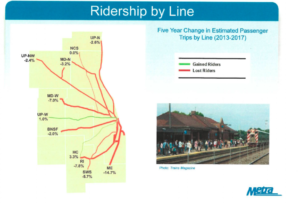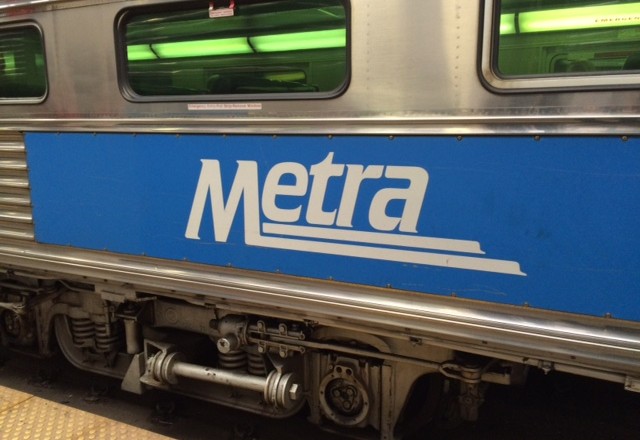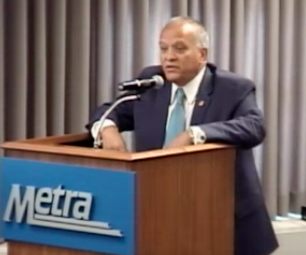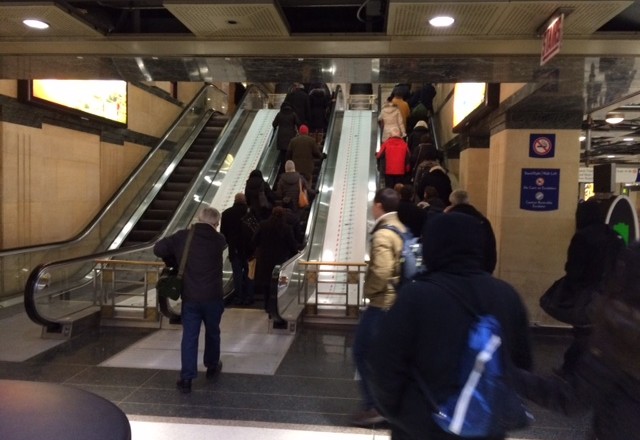Is Metra alarmed that ridership is quickly declining while employment in downtown Chicago is steadily rising?
Over the past five years, Metra’s ridership has slid 4.4 percent, and 2.2 percent last year alone.
The Electric District, serving the South Side and suburbs, plummeted 14.7 percent, the worst drop of Metra’s 11 lines.
Only one line, the Heritage Corridor, serving the Southwest Suburbs, showed healthy increases, up 3.3 percent during the last five years. But the Heritage Corridor is Metra’s least-used line, with only 2,400 weekday riders.
The Union Pacific West line, serving the western suburbs, showed a 1 percent increase over the last 5 years.
What’s going on here?
The data was presented at Metra’s board of directors meeting Wednesday. Board members expressed concern, but alarm bells didn’t seem to be going off.
Here’s some data, as presented by Lynette Ciavarelli, Metra’s top research person (director of strategic capital planning).
- Metra provided 78.6 million trips in 2017, down from 83.4 million trips in 2014. (By contrast, Metra provided a record 86.8 million trips in 2008.)
- Ridership on Metra’s busiest line, the BNSF to Aurora and booming Naperville, dropped 2 percent over five years. The BNSF line provides 63,900 weekday rides.
- Metra’s peak period ridership levels held steady over the past five years, but off-peak levels fell. (Are these people driving Downtown?)
- Metra paid an outside consultant to discover that for every fare increase of 10 percent, the agency sees a ridership drop of 2.2 percent. Metra has raised fares four times in four years.
- The employment rate in downtown Chicago — the destination for most of Metra’s riders — rose 0.3 percent in 2016, continuing a seven-year upward trend, according to state of Illinois data.
- Metra says 90 percent of all its trips are made by commuters. (Metra provides 709 weekday trains carrying 288,000 weekday riders.)
Here are some factors affecting Metra ridership, according to Ciavarelli:
- More people are telecommuting. (Metra Chairman Norman Carlson remarked that conductors are seeing fewer riders on Fridays than they do on Mondays.) Monthly pass purchases are down, while 10-Ride ticket sales are rising. (Another sign of more telecommuting.)
- Cold weather depresses ridership.
- Gasoline prices are much more reasonable now than they were a few years ago ($2.40/gal. vs. $3-$4/gal.).
- Some new technology is good for Metra: Ventra, Metra’s mobile ticketing app, has proven quite popular with riders, and ride-sharing apps Uber and Lyft are helping provide “last-mile” assistance to Metra riders.
- Some new technology is bad for Metra: Apps that direct motorists to in-city parking availability and travel apps, such as Google maps and Waze, are taking some of the unpredictability out of driving.
As mentioned, board members seemed concerned, but not alarmed.
For example, Romayne Brown, who represents Cook County, questioned what happened to those Electric District riders. (In November, Metra revised the line’s schedule to “match train times with operating conditions and reduce congestion.”) Ciavarelli responded to Brown by saying that there’s been a decline in population density along the Electric District corridor.
Maybe. But are South Siders finding the CTA to be a better bargain?
A topic for another day, along with other thoughts. Comments welc ome.
ome.
A version of this post originally appeared in Trains magazine.


